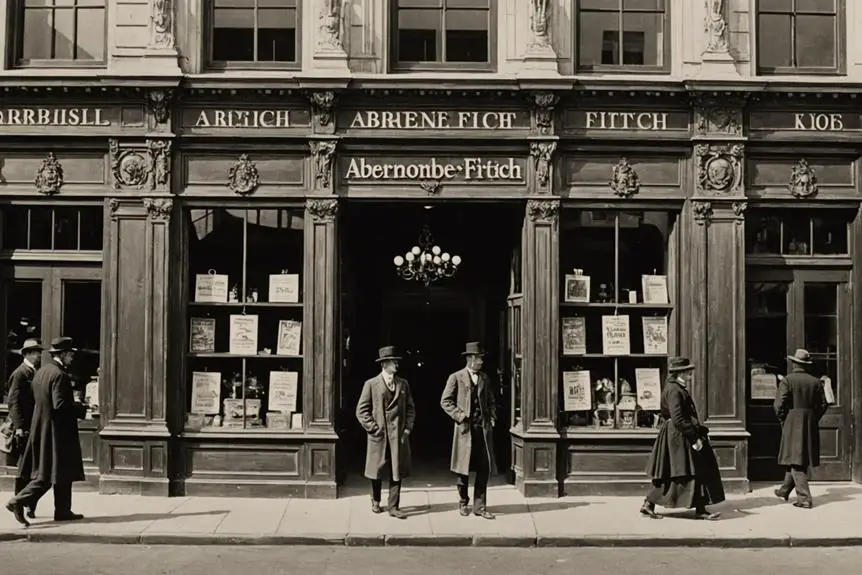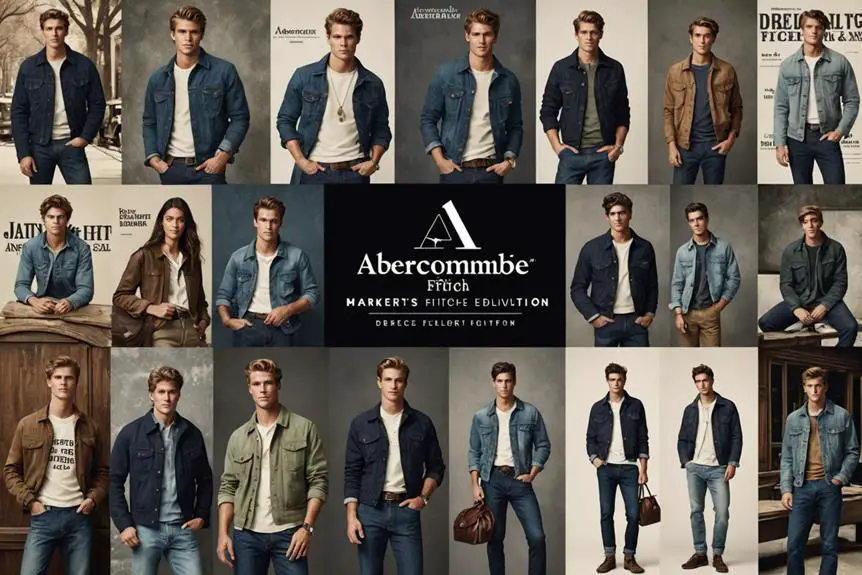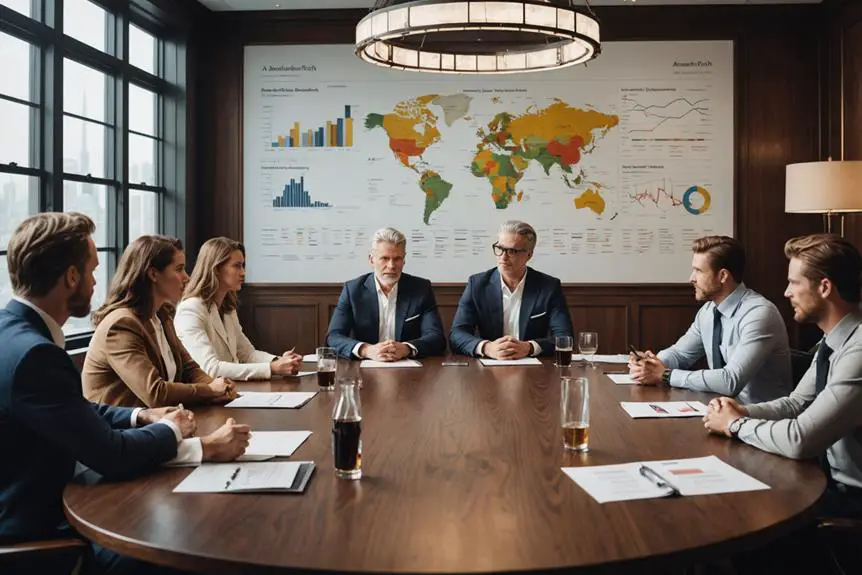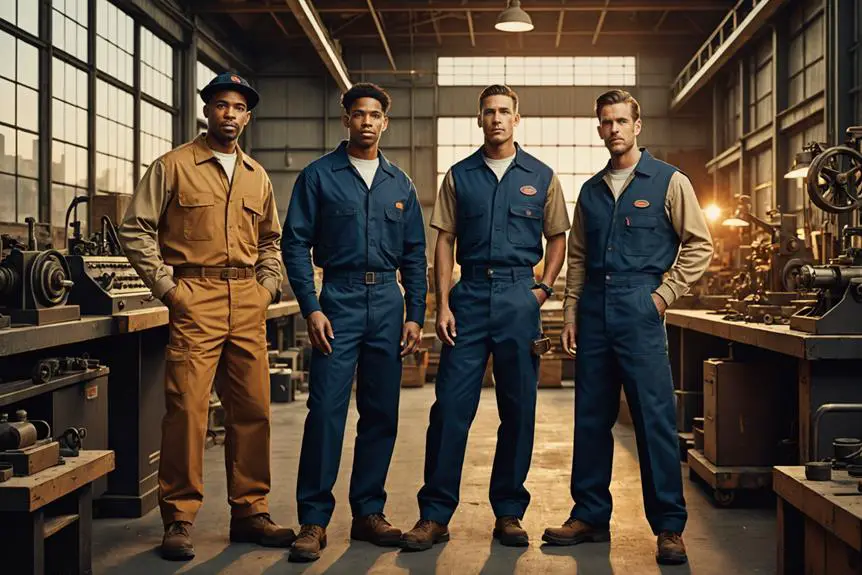Abercrombie & Fitch's history is a captivating tale of transformation and controversy. Established in 1892, the brand originally specialized in sporting goods before reinventing itself as a cultural icon, reaching a peak revenue of $3.749 billion in 2007. Known for its provocative marketing strategies, Abercrombie & Fitch garnered global attention, but also faced significant backlash and controversies over its branding approach. In recent years, the company has made a concerted effort to embrace inclusivity, aligning its image with modern values and sensibilities. This evolution has revitalized its appeal among younger consumers. As the brand continues to adapt its strategies and objectives, there is much more to explore regarding its iconic journey and how it navigates the ever-changing fashion landscape.
Founding and Early Development

From its inception in 1892, Abercrombie & Fitch quickly established itself as a cornerstone of American outdoor retail. Founded by David T. Abercrombie in Manhattan, the company initially focused on high-quality sporting goods and outdoor gear, attracting a niche clientele dedicated to exploration and adventure. The transformative partnership with Ezra Fitch in 1900 was pivotal; Fitch's significant stake and vision directed the company toward broader horizons. By 1904, Abercrombie & Fitch became the official name, reflecting this shift.
The brand's evolution accelerated with the release of a 456-page catalog in 1909, showcasing an extensive array of gear and clothing that captured the imagination of a global audience. In 1910, Abercrombie & Fitch boldly entered the women's clothing market, becoming the first store in New York to do so. This strategic move opened new demographics and solidified its position in the retail landscape. The 1917 opening of a flagship store on Madison Avenue symbolized American opulence, marking Abercrombie & Fitch as a cultural icon. These early developments laid the groundwork for a legacy that would endure through decades of change and growth.
Expansion and Popularity
During the late 1990s and early 2000s, Abercrombie & Fitch experienced a remarkable expansion that transformed it into a dominant force in the retail industry. The brand's popularity peaked around 2007, with revenue soaring to $3.749 billion, largely due to its appeal among young adults and teenagers. The introduction of Hollister Co. in 2000 was pivotal, targeting the pre-teen market and considerably contributing to overall growth.
Key aspects of this expansion included:
- Nearly 1,000 retail units operational by the early 2010s, showcasing widespread presence in the American retail landscape.
- The opening of a flagship store in London in 2007, marking Abercrombie's first major step into the European market and reinforcing its international expansion strategy.
- A notable resurgence in recent years, as the company adapted to changing consumer preferences despite earlier challenges.
This strategic focus on expansion and popularity not only solidified Abercrombie & Fitch's status but also shaped the trajectory of its brand evolution in an increasingly competitive retail environment.
Marketing Strategies and Brand Evolution

In the 1990s, Abercrombie & Fitch underwent a significant transformation under CEO Michael Jeffries, shifting from its roots in high-quality outdoor gear to a casual luxury brand aimed at the youth market. The brand's marketing strategies centered around provocative advertising, leveraging the allure of models and racy campaigns to capture attention and foster cultural relevance.
| Marketing Strategy | Impact on Brand |
|---|---|
| Provocative Advertising | Attracted youth culture |
| A&F Quarterly Magazine | Created brand loyalty |
| Shift to Inclusive Marketing | Broadened consumer base |
| Phasing Out Iconic Logo | Modernized image |
| Spontaneous Shopping Experiences | Enhanced customer engagement |
However, as backlash grew over hypersexualized ads, Abercrombie pivoted in the 2010s toward inclusive marketing strategies. Following Jeffries' exit in 2014, the brand embraced a rebranding strategy that aimed to resonate with evolving consumer values, particularly targeting those aged 18 to 25. These adaptations have contributed to a sales resurgence, demonstrating how Abercrombie & Fitch can evolve and remain relevant in a competitive marketplace.
Challenges and Controversies
Challenges and controversies have long shadowed Abercrombie & Fitch, often stemming from its provocative marketing and exclusivity-driven ethos. The brand faced substantial public backlash in 2002 when an offensive T-shirt design sparked outrage among Asian Americans, leading to calls for boycotts. This incident highlighted the brand's struggle with sensitivity in its marketing strategies.
Moreover, Abercrombie's involvement in a class-action lawsuit in 2003 over discriminatory hiring practices resulted in a $40 million settlement and mandated changes in their employment policies. CEO Mike Jeffries' controversial comments in 2013, emphasizing the brand's focus on exclusivity and specific body types, only fueled the fire, leading to further negative public perception.
Key moments in Abercrombie's controversies include:
- 2004 protests over shirts mocking sports and promoting negative stereotypes.
- The fallout from Jeffries' exclusivity comments, which alienated potential customers.
- The introduction of larger sizes in 2013, marking a significant shift towards inclusivity.
These challenges reveal how deeply rooted issues in Abercrombie & Fitch's identity have influenced its trajectory, forcing the company to reconsider its marketing approach and values.
Recent Developments and Leadership Changes

Recent years have marked a significant turnaround for Abercrombie & Fitch, particularly following the resignation of longtime CEO Michael Jeffries in December 2014. This shift paved the way for Fran Horowitz, who took over as CEO in February 2017. Under her leadership, the company made essential changes to its marketing strategy, moving away from sexually charged advertising and embracing a more inclusive approach. This new direction not only aimed to enhance customer service but also resonated with evolving consumer values.
In January 2017, Abercrombie & Fitch underwent a restructuring that included terminating 150 Home Office employees to streamline operations. These leadership changes were instrumental in revitalizing the brand's identity, allowing it to better connect with a younger demographic. The results of these strategic shifts became evident when the company reported its best second-quarter operating income since 2008 in Q1 2021.
This focus on inclusivity and responsiveness to consumer preferences illustrates a commitment to transforming the brand while steering through a challenging retail landscape. As Abercrombie & Fitch continues to adapt, it reflects a broader industry trend towards authenticity and alignment with contemporary consumer values.
International Expansion and Store Operations
Following the brand's revitalization under new leadership, Abercrombie & Fitch set its sights on international expansion as a key growth strategy. Beginning in 2005, the company opened its first non-U.S. stores in Toronto and Edmonton, later launching a European flagship store in London by 2007. This strategic move not only enhanced brand visibility but also positioned Abercrombie to target major cities like Milan, Copenhagen, Paris, and Madrid through its European office in Mendrisio, Switzerland.
As of February 2020, Abercrombie operated 854 stores, with plans to reach a staggering 31,700 by February 2024. You'll find flagship stores in key Asian markets, including the first in Tokyo in 2009, and expansions into Fukuoka, Singapore, Hong Kong, and Seoul, focusing on the Chinese and Japanese markets.
- Model stores at the Home Office in New Albany allow for effective merchandising testing.
- Store operations are optimized through meticulous layout design.
- The focus on major cities enhances brand accessibility and market presence.
This strategic approach illustrates Abercrombie's commitment to a robust international presence while refining its store operations.
Frequently Asked Questions
What Caused the Fall of Abercrombie and Fitch?
You'll find that Abercrombie & Fitch's decline stemmed from controversial marketing, legal issues, and competition from fast fashion. Their refusal to adapt alienated consumers, leading to significant sales drops and store closures.
What Was the Abercrombie and Fitch Scandal?
The Abercrombie & Fitch scandal involved discriminatory hiring practices, racially insensitive designs, and controversial marketing strategies. You'll notice how these issues sparked public outrage, leading to lawsuits and a significant brand image overhaul.
How Did Abercrombie and Fitch Turn Around?
Abercrombie & Fitch turned around by embracing inclusivity, renaming models to brand representatives, phasing out logos, launching appealing collections, and expanding sizes. These strategies attracted a diverse audience and revitalized their brand image effectively.
What Are Some Fun Facts About Abercrombie and Fitch?
You might find it interesting that Abercrombie & Fitch initially focused on high-end sporting goods, and their unique marketing strategies, like racy ads, considerably shaped their brand identity, attracting a youthful, trend-driven audience.





https://digi188sa.netlify.app/research/digi188sa-(438)
Saks is easily top-of-the-line department shops for purchasing a mother-of-the-bride costume.
https://je-tall-marketing-809.lon1.digitaloceanspaces.com/research/je-marketing-(75).html
This brocade robe attracts the eye to all the best places—from
a hint of pores and skin on the shoulder to a ruched waist.
https://je-sf-tall-marketing-715.b-cdn.net/research/je-marketing-(295).html
Before you start your search (around the
six- to eight-month mark), brush up on mother-of-the-bride attire etiquette.
https://je-tall-marketing-801.sgp1.digitaloceanspaces.com/research/je-marketing-(9).html
Make certain to let the mom of the groom know what you could be wearing.
https://digi60sa.fra1.digitaloceanspaces.com/research/digi60sa-(422).html
Saks is well one of the best malls for purchasing a mother-of-the-bride dress.
https://digi599sa.z29.web.core.windows.net/research/digi599sa-(422).html
But I is not going to select any of the outfits you may have shown.
https://objectstorage.ap-tokyo-1.oraclecloud.com/n/nrswdvazxa8j/b/digi502sa/o/research/digi502sa-(250).html
To help you in your search, we’ve accomplished the exhausting
work for you!
https://digi652sa.netlify.app/research/digi652sa-(426)
They additionally create an elongating, slimming effect as they draw the attention up
and down quite than across.
https://digi61sa.nyc3.digitaloceanspaces.com/research/digi61sa-(372).html
Straight-leg pants create a streamlined silhouette that subtly enhances the velvet burnout-print prime and jacket.
https://digi58sa.ams3.digitaloceanspaces.com/research/digi58sa-(470).html
Adhere to the dress code, and look to bridesmaids or the marriage robe for guidance on daring patterns or
embellishments.
https://je-tall-marketing-772.sgp1.digitaloceanspaces.com/research/je-marketing-(109).html
You don’t need to wear shiny pink for instance, if the type of the day is extra natural and muted.
https://je-tall-marketing-785.blr1.digitaloceanspaces.com/research/je-marketing-(271).html
This robe comes full with slits in the sleeves to keep her cool at an out of doors marriage ceremony this summer.
https://digi647sa.netlify.app/research/digi647sa-(168)
Mother of the Bride and Groom attire within the newest styles and colors.
https://je-tall-marketing-778.fra1.digitaloceanspaces.com/research/je-marketing-(443).html
So, you’ll need to wear one thing that doesn’t clash with the remainder of the group in photos.
https://je-tall-marketing-814.sgp1.digitaloceanspaces.com/research/je-marketing-(400).html
For a seaside marriage ceremony I would wear something a bit more
flowy like the flowery and ruffly clothes above.
https://je-tall-marketing-794.fra1.digitaloceanspaces.com/research/je-marketing-(338).html
Opt for a well-cut, flowing sundress in a breathable fabric—and pair with dressy sandals to pull the look together (while
nonetheless feeling comfortable on the sand!).
https://je-tall-marketing-796.lon1.digitaloceanspaces.com/research/je-marketing-(165).html
If you are a Nordstrom common, you may be happy to know the beloved retailer
has an extensive collection of mother-of-the-bride attire.
That is a good tip especially to those new to the blogosphere.
Brief but very accurate information… Appreciate your sharing this one.
A muxt read post!
https://je-tall-marketing-777.blr1.digitaloceanspaces.com/research/je-marketing-(35).html
These robes are stylish and fashionable with only a bit of
an edge.
https://je-tall-marketing-807.blr1.digitaloceanspaces.com/research/je-marketing-(214).html
Not sure which color will work to greatest coordinate the mothers of the bride and groom with the the rest of the
bridal party?
https://je-tall-marketing-816.blr1.digitaloceanspaces.com/research/je-marketing-(369).html
But it’s important to verify in with the bride earlier than you make any decisions.
https://digi659sa.netlify.app/research/digi659sa-(488)
Here are 10 of the most effective mother of the bride clothes for this yr.
https://digi658sa.netlify.app/research/digi658sa-(435)
One mother’s blush apparel appeared lovely in opposition to these two brides’ romantic marriage ceremony clothes.
I don’t think the title of your article matches the content lol. Just kidding, mainly because I had some doubts after reading the article. https://www.binance.info/sl/register?ref=PORL8W0Z